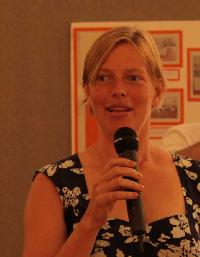| Pages sur ce sujet: [1 2] > | Technical non-fiction with complex layout Auteur du fil: Gareth Evans
|
|---|
Hello, I'm new here and am looking into getting my book(s) translated.
My books contain text from top to bottom but also have side to side layout in some places, with pictures to the side of text, which makes paragraph size affect the layout. I think this would not be ideal for a translator to work from knowing that different languages can use different amounts of words.
What I thought would work, would be for me to take out all the graphics and make the book just text ... See more Hello, I'm new here and am looking into getting my book(s) translated.
My books contain text from top to bottom but also have side to side layout in some places, with pictures to the side of text, which makes paragraph size affect the layout. I think this would not be ideal for a translator to work from knowing that different languages can use different amounts of words.
What I thought would work, would be for me to take out all the graphics and make the book just text from top to bottom for the translator to put the translation of each paragraph under each. This way I know what all the paragraphs are when I put the graphics back in and the translator can work from the same file paragraph by paragraph.
I have a couple of examples from one page of my book. I can't see how to post pictures on here (perhaps as a new member I can't do that yet) so I put my examples on a link as follows:
Here is the original English version with layout....
https://postimg.cc/jD4PbkQD
Here is the version prepared for translation. All graphics removed, with space under each paragraph for translation of each paragraph. The red text "translation" wouldn't need to be there, that's just to help explanation...
https://postimg.cc/yJNgz68G
If some graphics need to move to the next page due to more words and the book becomes a few pages longer, that's not an issue for me at all, after all it's the same the work I would have done for the layout anyway when writing the book in the fist place.
As translators I wonder what you think? I wonder if anyone has experience with this kind of thing?
Regards,
Gareth ▲ Collapse
| | | | Samuel Murray 
Pays-Bas
Local time: 14:54
Membre (2006)
anglais vers afrikaans
+ ...
Gareth Evans wrote:
My books contain text from top to bottom but also have side to side layout in some places, with pictures to the side of text, which makes paragraph size affect the layout. I think this would not be ideal for a translator to work from knowing that different languages can use different amounts of words.
It's nice of you to think of the translator, but I suggest you let the translator figure out what is best for himself. If you give a translator the full version (with formatting and images intact), then he can translate it, and then you can simply check afterwards if maybe you need to change the font size of certain blocks of text, etc.
I assume you don't have the option of letting the text flow underneath the image, if the text is much too long to fit only to the left or right of the image. It looks like you're using tables, and putting images inside whole cells. What you can possibly do is to tell the translator that he should feel free to create an extra row underneath the image and text, and put the overrun text in there. Or, if he wants to, he can take the first sentence or two from the left-hand cell and move it to the previous row.
A completely different idea would be to just reduce the font size for the entire book slightly, to ensure that all text fits in.
Or: you can simply tell the translator not to worry about the layout, and just translate every block of text in the same position, and then you can personally fix any layout issues afterwards.
Note: many translators are going to use CAT tools to do the translation, so it's important to tell them if you want them to be involved in moving text around into other cells as well. With a CAT tool, the translation of a block of text will be in the same position as the original block of text, but nothing more.
| | | | | Opinion: Keep the images | Dec 2, 2019 |
Personally, I would want the images to remain in place to aid my understanding of the text. Formatting issues can always be fixed later on.
| | | | Tina Vonhof (X)
Canada
Local time: 06:54
néerlandais vers anglais
+ ...
| Agree with Amel | Dec 2, 2019 |
Amel Abdullah wrote:
Personally, I would want the images to remain in place to aid my understanding of the text. Formatting issues can always be fixed later on.
One way to keep the layout is to insert a table with one row and two columns, put the text in the left box and the illustration in the right box. That way the layout will not change if more text is added. Later, you could make the borders invisible, center the picture in the box to make it look more on a level with the text and, if possible, move the center line to give as much space as possible to the text. The latter depends on the pictures that follow because you would want the layout to be the same for all of them.
P.S. I'm talking about tables in MS Word here. I don't know how it would work with other word processors or CAT tools.
[Edited at 2019-12-02 17:29 GMT]
| | |
|
|
|
| Thanks for your inputs | Dec 2, 2019 |
Samuel Murray wrote:
It's nice of you to think of the translator, but I suggest you let the translator figure out what is best for himself. If you give a translator the full version (with formatting and images intact), then he can translate it, and then you can simply check afterwards if maybe you need to change the font size of certain blocks of text, etc. I assume you don't have the option of letting the text flow underneath the image, if the text is much too long to fit only to the left or right of the image. It looks like you're using tables, and putting images inside whole cells.
I would send the translator the original layout version also for them to see what they think. It’s an MS word file. I think see what you mean regarding tables, everything would be contained and be limited in how it might move around.
Unfortunately I’m not using tables. The text that isn’t from left to right page sides is in text boxes. Text boxes and images vary between different settings so they would behave differently with the effects of translation of text. Some text / images would end up overlapping other text / images and appearing on the wrong pages and even next to wrong text, making layout completely wrong and quite a mess, unless the translator re-arranges and corrects the layout, which is something I would want to do myself anyway and not extra work I’d want to give them.
Samuel Murray wrote:
What you can possibly do is to tell the translator that he should feel free to create an extra row underneath the image and text, and put the overrun text in there. Or, if he wants to, he can take the first sentence or two from the left-hand cell and move it to the previous row.
Do you mean an extra row of text or table row? I’m not sure sure I’m familiar on this.
Samuel Murray wrote:
A completely different idea would be to just reduce the font size for the entire book slightly, to ensure that all text fits in.
That would help keep the layout the same for a translation that ends up with more words. Unfortunately the font size (12) is already the smallest I’d want it to be for this particular book’s paperback version (trim size 7.51 x 9.25 inches). Other books of mine are font size 13 with a larger trim size 8.27 x 11.69 inches.
Samuel Murray wrote:
Note: many translators are going to use CAT tools to do the translation, so it's important to tell them if you want them to be involved in moving text around into other cells as well. With a CAT tool, the translation of a block of text will be in the same position as the original block of text, but nothing more.
Is CAT a plug-in that can be used with a word processor? If on the other hand it’s a separate program I suppose this means the translator would have to open the file within the CAT program?
Amel Abdullah wrote:
Personally, I would want the images to remain in place to aid my understanding of the text. Formatting issues can always be fixed later on.
That would be a disadvantage to my method. Perhaps if the translator had the original layout also they could refer to it for that purpose. Unfortunately the images wouldn’t remain in place from the original layout version with translation and fixing that would be difficult for me because I wouldn’t know what text goes with what pictures, while I wouldn’t expect a translator to be responsible for creating the very different layout that would be required due to translation. In some cases only 1 line of text can determine whether an image should be on the next page or not. In any case I would send original layout version and see what the translator thinks.
| | | | John Fossey 
Canada
Local time: 08:54
Membre (2008)
français vers anglais
+ ...
| Agree with others | Dec 2, 2019 |
Gareth Evans wrote:
In any case I would send original layout version and see what the translator thinks.
Most translators would strongly agree. Please bear in mind that translators are dealing with layout issues every day and are intimately familiar with how layout is affected by their particular language pair and direction.
| | | | | Agree with others. | Dec 3, 2019 |
As translator, I'd like to receive the "for-translation" version (any editable format: DOC, DOCX, ODT, TXT etc.) AND the original (complete with illustrations: DOC, DOCX, ODT, or PDF) - in order to know exactly what I'll work on. The original is a "must-be" to me.
But the layout of your book is not complex. In opposite, it's very simple compared to various instructions manuals (with text flowing around images; with tables, formulas, ... See more As translator, I'd like to receive the "for-translation" version (any editable format: DOC, DOCX, ODT, TXT etc.) AND the original (complete with illustrations: DOC, DOCX, ODT, or PDF) - in order to know exactly what I'll work on. The original is a "must-be" to me.
But the layout of your book is not complex. In opposite, it's very simple compared to various instructions manuals (with text flowing around images; with tables, formulas, icons etc.). Two examples:
https://karleyfoy.files.wordpress.com/2014/03/planetbike-protege9-0a.jpg ,
https://tdl-creative.com/app/uploads/2015/02/TDL-london-K-instruction-manual-final-design-1.png .
AM
[Zmieniono 2019-12-03 11:10 GMT] ▲ Collapse
| | | |
Andrzej Mierzejewski wrote:
As translator, I'd like to receive the "for-translation" version (any editable format: DOC, DOCX, ODT, TXT etc.) AND the original (complete with illustrations: DOC, DOCX, ODT, or PDF) - in order to know exactly what I'll work on. The original is a "must-be" to me.
But the layout of your book is not complex. In opposite, it's very simple compared to various instructions manuals (with text flowing around images; with tables, formulas, icons etc.). Two examples:
https://karleyfoy.files.wordpress.com/2014/03/planetbike-protege9-0a.jpg ,
https://tdl-creative.com/app/uploads/2015/02/TDL-london-K-instruction-manual-final-design-1.png .
AM [Zmieniono 2019-12-03 11:10 GMT]
Of course I'd send the original and in any formats asked for. True, my book is not incredibly complex, perhaps complex is the wrong word, rather than it being an issue of having both vertical and horizontal content, for which sometimes there's a lack of space for more text.
Interesting examples of layouts thanks. For the flip camera one below, I see there is space for extra text in many places apart from the "Declaration of Conformity" box to the right. If translation made that paragraph 3 to 4 lines longer, what would one do?
https://karleyfoy.files.wordpress.com/2014/03/242-flip_quickstart.png
[Edited at 2019-12-03 13:44 GMT]
| | |
|
|
|
Marjolein Snippe 
Pays-Bas
Local time: 14:54
Membre (2012)
anglais vers néerlandais
+ ...
| Nice project! | Dec 3, 2019 |
As others have pointed out, the page you showed is not considered complex in terms of layout.
If you need the translation in word format, just send the translator the original (English) word document and indicate you will need it back with formatting. Or, if you prefer, send them the original English version plus a version with only text and tell the translator you just need the unformatted translation so that you can put the images exactly where you want them to be.
A CAT to... See more As others have pointed out, the page you showed is not considered complex in terms of layout.
If you need the translation in word format, just send the translator the original (English) word document and indicate you will need it back with formatting. Or, if you prefer, send them the original English version plus a version with only text and tell the translator you just need the unformatted translation so that you can put the images exactly where you want them to be.
A CAT tool is often a separate programme but can also work as a sort of plug-in in Word (I know Wordfast Classic works this way, but there may be more).
When used as a separate programme, the tool can import most standard file types (although pdf files can be problematic) and take care of most of the formatting, so the translation looks more or less like the original - although a final check by the translator or another speaker of that language should still be done.
If you are interested enough, a trial version of Wordfast (both the standalone Pro version and the plugin Classic version) can be downloaded free of charge here to get an idea:
https://www.wordfast.com/store_download.html
(There may be other CAT tools offering free trial versions - all a little different but the general idea will be the same.)
A final comment: make sure you budget for translation - it can be more expensive than some people expect...
Good luck! ▲ Collapse
| | | |
Marjolein Snippe wrote:
As others have pointed out, the page you showed is not considered complex in terms of layout.
If you need the translation in word format, just send the translator the original (English) word document and indicate you will need it back with formatting. Or, if you prefer, send them the original English version plus a version with only text and tell the translator you just need the unformatted translation so that you can put the images exactly where you want them to be.
I'll do that.
Marjolein Snippe wrote:
A CAT tool is often a separate programme but can also work as a sort of plug-in in Word (I know Wordfast Classic works this way, but there may be more).
When used as a separate programme, the tool can import most standard file types (although pdf files can be problematic) and take care of most of the formatting, so the translation looks more or less like the original - although a final check by the translator or another speaker of that language should still be done.
If you are interested enough, a trial version of Wordfast (both the standalone Pro version and the plugin Classic version) can be downloaded free of charge here to get an idea:
https://www.wordfast.com/store_download.html
(There may be other CAT tools offering free trial versions - all a little different but the general idea will be the same.)
When writing books I don't tend to edit PDF files either. I just downloaded WordFast Classic and it seems to be working as a plug-in on my MS Word, I will have a look at that.
Marjolein Snippe wrote:
A final comment: make sure you budget for translation - it can be more expensive than some people expect...
Good luck!
Indeed. I won't forget the book's sales page description and relevant website pages will need translation also, and proofreading. Thanks, I look forward to translating in near future.
| | | | Erik Freitag 
Allemagne
Local time: 14:54
Membre (2006)
néerlandais vers allemand
+ ...
| If you're the author, don't bother dealing with CAT tools | Dec 3, 2019 |
I strongly agree with the notion that you should just provide the chosen translator with the original Word file. Today, any translator worth their salt will be able to produce a translation that generally preserves the original layout. If you don't want to fix layout issues (which will occur to varying degrees) yourself, some translators may even offer additional formatting services. Or you could hire a DTP provider.
I would strongly suggest that you not busy yourself with an... See more I strongly agree with the notion that you should just provide the chosen translator with the original Word file. Today, any translator worth their salt will be able to produce a translation that generally preserves the original layout. If you don't want to fix layout issues (which will occur to varying degrees) yourself, some translators may even offer additional formatting services. Or you could hire a DTP provider.
I would strongly suggest that you not busy yourself with any CAT tools. Leave the choice of tools to your translator. Many clients don't recognize this, but limiting the pool of possible translators by prescribing a certain software programme usually is a bad idea. In your case, that pool of qualified professionals will be small to begin with, so you don't want to exclude those who don't use your preferred CAT tool.
[Edited at 2019-12-03 18:18 GMT] ▲ Collapse
| | | | Samuel Murray 
Pays-Bas
Local time: 14:54
Membre (2006)
anglais vers afrikaans
+ ...
Gareth Evans wrote:
Unfortunately, I’m not using tables. The text that isn’t from left to right page sides is in text boxes. Text boxes and images vary between different settings so they would behave differently with the effects of translation of text.
Well, personally I find text boxes very difficult to deal with, and I consider formatting with text boxes to be something that I can't offer my clients. I'm sure there are translators for whom working with text boxes is easy peasy, but for me it's very difficult. If a client sent me a file with text boxes, it would make me very happy if the client said "don't worry about fixing layout errors -- I'll do that myself -- just make sure each text box's translation is in the text box and that the font formatting is correct".
Most CAT tools can deal with text boxes in Word just fine. However, it's like you said: the boxes sometimes move, and this has to be fixed by a human manually.
Sorry, in my original reply I assumed (a) tables and I assume that (b) the file format is MS Word. Can you tell us what the file format is? Is it MS Word, or is it something else?
Is CAT a plug-in that can be used with a word processor? If on the other hand it’s a separate program I suppose this means the translator would have to open the file within the CAT program?
CAT tools are separate programs that translators buy themselves. These CAT tools can open translatable documents (e.g. Word files), even with complex formatting, and make it easier for translators to access the translatable text, even if the translators are not experts in those formats (e.g. a translator who doesn't know how to use Word can still translate a Word file, in his CAT tool). The CAT tools are quite good at retaining layout and formatting of documents, but obviously they're not perfect. Someone (the translator, or the client) still has to check the final file and fix layout errors. Some CAT tools can help the translator save time (e.g. when translating highly repetitive text), and some commercial clients (e.g. translation agencies) then expect translators to give them a discount based on this time-saving, but you'll make the translator very happy if you don't demand such discounts.
Marjolein Snippe wrote:
If you are interested enough, a trial version ... can be downloaded free of charge to get an idea...
but...
Erik Freitag wrote:
I would strongly suggest that you not busy yourself with any CAT tools. Leave the choice of tools to your translator.
I agree with Erik. If you want to familiarise yourself with CAT tools and what they can do, watch some videos on YouTube. Major CAT tools include Wordfast, OmegaT, Trados, MemoQ, CafeTran etc.
You (the client) should not be doing anything with a CAT tool. I mentioned CAT tools simply because it's likely that a translator will use one.
However:
If it is easier for you personally to give the text to the translator in the format that you showed initially (the file without the images), then feel free to do that. An alternative to placing the translation *underneath* the source text, is to place the translation next to the source text, in a table, which would be equally useful for you, but easier for me (personally) to produce.

I mentioned CAT tools to let you know that translators can often translate these formats quite easily. But... I also know that some clients who work with documents that involve complex layouts actually prefer that translators give them the translation in a table, and not in the actual final format. Such clients do not mind copy/pasting the text, because they retain more control over the process.
[Edited at 2019-12-03 18:38 GMT]
| | |
|
|
|
Samuel Murray wrote:
Well, personally I find text boxes very difficult to deal with, and I consider formatting with text boxes to be something that I can't offer my clients. I'm sure there are translators for whom working with text boxes is easy peasy, but for me it's very difficult. If a client sent me a file with text boxes, it would make me very happy if the client said "don't worry about fixing layout errors -- I'll do that myself -- just make sure each text box's translation is in the text box and that the font formatting is correct".
Most CAT tools can deal with text boxes in Word just fine. However, it's like you said: the boxes sometimes move, and this has to be fixed by a human manually.
Sorry, in my original reply I assumed (a) tables and I assume that (b) the file format is MS Word. Can you tell us what the file format is? Is it MS Word, or is it something else?
No problem. The format is MS word. I have found editing with text boxes in my own language a challenge also and I have learned over time. The layout is one of the very last things I do once the amount of text is final.
Erik Freitag wrote:
I would strongly suggest that you not busy yourself with any CAT tools. Leave the choice of tools to your translator.
Agreed. I was merely curious to see one. Whatever the translator works with is up to them.
Samuel Murray wrote:
However:
If it is easier for you personally to give the text to the translator in the format that you showed initially (the file without the images), then feel free to do that. An alternative to placing the translation *underneath* the source text, is to place the translation next to the source text, in a table, which would be equally useful for you, but easier for me (personally) to produce.
I mentioned CAT tools to let you know that translators can often translate these formats quite easily. But... I also know that some clients who work with documents that involve complex layouts actually prefer that translators give them the translation in a table, and not in the actual final format. Such clients do not mind copy/pasting the text, because they retain more control over the process.
[Edited at 2019-12-03 18:38 GMT]
I like the side by side table idea. It is interesting for me to have some insight into what some other clients do thank you. Similarly I would prefer that method. Sometimes a single line of text can determine whether an entire diagram should be on the next page, or the text, if relevant to the diagram, taken with the diagram to the next page, leaving some space on the former page. If a translator did the layout too I would not be able to check that the paragraphs are all in the right places and with the right diagrams as they would be in a foreign language. Unfortunately things can move around rather unpredictably when altered. Separating text for the translator would solve all that and let me see what each paragraph is in English by just looking across to the left of your table.
If it was an eBook ePub format there would be no issue because it's continuous top to bottom with all text and graphics stacked vertically and no pages splitting anything. I actually have to change the layout for eBook format from print for this reason but that's another story.
By the way how did you make that table with my text?
[Edited at 2019-12-03 21:01 GMT]
| | | | Samuel Murray 
Pays-Bas
Local time: 14:54
Membre (2006)
anglais vers afrikaans
+ ...
Gareth Evans wrote:
By the way, how did you make that table with my text?
1. Load the JPG into Abbyy FineReader 14. Let FineReader do it's magic (OCR). Since this was just for illustration, it didn't matter if the OCR introduced mistakes into the text, and I did not check if it did.
2. Copy the text into MS Word. (And hope that there aren't any text boxes!)
3. Select all text, and convert to a 1-column table (you may need to fiddle with the settings, or do some temporary find/replacing to deal with soft line breaks and tabs).
4. Reduce the width of the table to about half of the page, then add a second column using MS Word's usual method of adding columns to a table.
You'll notice that whole paragraphs end up in a single cell. This makes more sense to me because it would require fewer copy/paste actions for the client. However, if you tell a translator to create the table himself, you *might* get a table back in which every sentence is in a separate cell, depending on how the translator creates the table -- since CAT tools allow us to split paragraphs into sentences, and most CAT tools can then help one to save the text easily in a format that can be converted to a table.
If you find it hard to select and copy from such a table, simply highlight the source column (e.g. yellow), and then convert the table to text, with paragraphs breaks instead of tabs. That will put the translation underneath each piece of source text, and you can select text more easily.
[Edited at 2019-12-04 08:05 GMT]
| | | | | I'd do it like this: | Dec 4, 2019 |
Gareth Evans wrote:
For the flip camera one below, I see there is space for extra text in many places apart from the "Declaration of Conformity" box to the right. If translation made that paragraph 3 to 4 lines longer, what would one do?
In such case all you can do is try to make the translation shorter..., and shorter..., and even shorter. Just remove all unnecessary words. It's the translator's decision which words must remain, and which can be deleted without any harm to the clarity and comprehension of the text.
The last resort is: a smaller font size.
As to your book: if I were your translator, I'd use Samuel Murrays' solution with two columns. This method always facilitates the actual editor's job.
HTH
AM
| | | | | Pages sur ce sujet: [1 2] > | To report site rules violations or get help, contact a site moderator: You can also contact site staff by submitting a support request » Technical non-fiction with complex layout | LinguaCore | AI Translation at Your Fingertips
The underlying LLM technology of LinguaCore offers AI translations of unprecedented quality. Quick and simple. Add a human linguistic review at the end for expert-level quality at a fraction of the cost and time.
More info » |
| | CafeTran Espresso | You've never met a CAT tool this clever!
Translate faster & easier, using a sophisticated CAT tool built by a translator / developer.
Accept jobs from clients who use Trados, MemoQ, Wordfast & major CAT tools.
Download and start using CafeTran Espresso -- for free
Buy now! » |
|
| | | | X Sign in to your ProZ.com account... | | | | | |


















